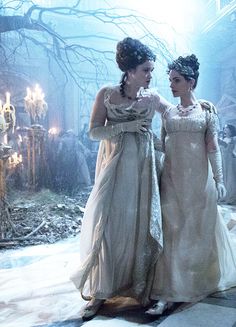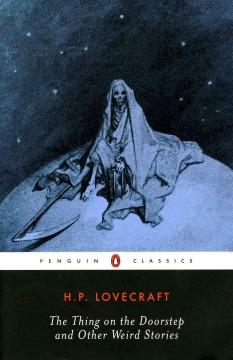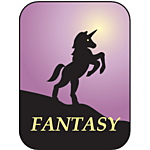
Good friends…they aren’t easy to find in this world. But good friends are often the ones who show you the sides of yourself that you didn’t know were there, and introduce you to books you might never have read.
Take, for example, an exchange between myself, and our fabulous Saturday Blogger, who goes by the name of Lady Pole. Unsurprisingly, books are involved in a fair bit of our conversations (and, one book in particular, if you haven’t noticed…). But after our discussions about genre fiction a few weeks back, Lady Pole, in all her splendidness, went and created a Pinterest board titled “Fantastic Fantasy“, showcasing the fantasy novels we’ve discussed here at the Free For All.*
When she first told me about this board, I was delighted, but also surprised. Because if you had asked me five minutes beforehand, I would have told you that I wasn’t a big reader of fantasy books at all.
But the longer I looked through the books on our list, the more I began to appreciate just how diverse the fantasy genre really and truly is. Up until Lady Pole’s intervention, I would have told you that fantasy novels were ones with dragons in them. Possibly warlocks. And unicorns. But that was about it.
In the interest of full disclosure, it appears that my definition was limited by the fact that I believe that magic, ghosts, fairies, leprechauns, necromancers, and pyromancy are all completely real–and there’s nothing wrong with this. But it did impede me from seeing all these great elements as part of an enormous and hugely varied genre that incorporates more than I had personally ever imagined. (Just a note: these things are real. Never let a leprechaun hear you say that you think they aren’t real).
So, with that in mind, I thought I’d offer us both a little primer of some of the “subgenres” of fantasy so that you and I could both become a little more familiar with all that fantasy has to offer, and really come to appreciate a genre that re-invents fiction on a daily basis. (We’re going in alphabetical order here, so as to be fair to all the dragons and leprechauns and unicorns)
 Dark Fantasy: This subgenre walks a fine line between fantasy and horror, incorporating elements of both to make for a story that is intentionally frightening, unsettling, and generally creepy. Charles L. Grant, a pioneer of the dark fantasy genre, defined it as “a type of horror story in which humanity is threatened by forces beyond human understanding”, though it has also come to be associated with stories from “The Monsters’ Point of View”. Think H.P. Lovecraft, Anne Rice’s Vampire Chronicles, and China Mieville’s Kraken.
Dark Fantasy: This subgenre walks a fine line between fantasy and horror, incorporating elements of both to make for a story that is intentionally frightening, unsettling, and generally creepy. Charles L. Grant, a pioneer of the dark fantasy genre, defined it as “a type of horror story in which humanity is threatened by forces beyond human understanding”, though it has also come to be associated with stories from “The Monsters’ Point of View”. Think H.P. Lovecraft, Anne Rice’s Vampire Chronicles, and China Mieville’s Kraken.
 High Fantasy: Here’s where the dragons and warlocks generally show up. High fantasy books are generally set in a completely different world from our own; worlds with their own rules and population, that generally tend to be pretty epic in their scope (Tolkien invented a language for his characters). These are the kind of books that tend to get the “Fantasy” stickers with the glowing unicorn on their spines. Think J.R.R. Tolkien, Terry Brooks, and C.S. Lewis’ Chronicles of Narnia.
High Fantasy: Here’s where the dragons and warlocks generally show up. High fantasy books are generally set in a completely different world from our own; worlds with their own rules and population, that generally tend to be pretty epic in their scope (Tolkien invented a language for his characters). These are the kind of books that tend to get the “Fantasy” stickers with the glowing unicorn on their spines. Think J.R.R. Tolkien, Terry Brooks, and C.S. Lewis’ Chronicles of Narnia.
 Historical Fantasy: Now this is a subgenre with subgenres, making it a bit of a tricky category to cover quickly. Very broadly speaking, these books tend to take place in a past full of magical/fantastical/paranormal elements. Sometime that can be a familiar past, like Jonathan Strange and Mr. Norrell, or an alternative past, like Keith Roberts’ Pavane, which is set in a world where the Spanish Armada defeated the Elizabeth I. They can also deal with fairytales and folklore, as in Bill Willingham’s Peter and Max. Steampunk, which usually imagines a Victorian world where steam, rather than electricity, became the dominant source of power, also falls generally within this genre. Check out: Aurorarama by Jean-Christophe Valtat, Neil Gaimain’s Stardust, or V.E. Schwab’s A Darker Shade of Magic.
Historical Fantasy: Now this is a subgenre with subgenres, making it a bit of a tricky category to cover quickly. Very broadly speaking, these books tend to take place in a past full of magical/fantastical/paranormal elements. Sometime that can be a familiar past, like Jonathan Strange and Mr. Norrell, or an alternative past, like Keith Roberts’ Pavane, which is set in a world where the Spanish Armada defeated the Elizabeth I. They can also deal with fairytales and folklore, as in Bill Willingham’s Peter and Max. Steampunk, which usually imagines a Victorian world where steam, rather than electricity, became the dominant source of power, also falls generally within this genre. Check out: Aurorarama by Jean-Christophe Valtat, Neil Gaimain’s Stardust, or V.E. Schwab’s A Darker Shade of Magic.
 Urban Fantasy: Fantasy set in a city. Obviously. To be more specific, though, these books tend to resemble in many ways the noir detective stories of the mid-20th century: they frequently feature detectives, private eyes, or guns-for-hire who deal in the paranormal, and they often deal with the grittier side of life, and life in the city. Case in point: Mike Carey’s near-perfect Felix Castor series, P.N. Elrod’s Vampire Files, as well as Joseph Nasisse’s Eyes to See. Interestingly, urban fantasy is increasingly becoming a genre of heroines. Sometimes they find a hero along the way, and sometimes they don’t, but this subgenre is fast carving out a space for female heroines–and authors–to break all the rules, with some fantastic results. For examples, look for Adrian Phoenix’s Makers Song series, Kat Richardson’s Greywalker novels, and Chloe Neill’s super-terrific Chicagoland Vampire series.
Urban Fantasy: Fantasy set in a city. Obviously. To be more specific, though, these books tend to resemble in many ways the noir detective stories of the mid-20th century: they frequently feature detectives, private eyes, or guns-for-hire who deal in the paranormal, and they often deal with the grittier side of life, and life in the city. Case in point: Mike Carey’s near-perfect Felix Castor series, P.N. Elrod’s Vampire Files, as well as Joseph Nasisse’s Eyes to See. Interestingly, urban fantasy is increasingly becoming a genre of heroines. Sometimes they find a hero along the way, and sometimes they don’t, but this subgenre is fast carving out a space for female heroines–and authors–to break all the rules, with some fantastic results. For examples, look for Adrian Phoenix’s Makers Song series, Kat Richardson’s Greywalker novels, and Chloe Neill’s super-terrific Chicagoland Vampire series.
It’s also really important to remember that these classifications are by no means hard and fast. George R.R. Martin’s Game of Thrones is as much high fantasy as it is historical fantasy. Jim Butcher’s Dresden Files are urban fantasy, but they can be shelved in mystery, as well. A vast number of steampunk books are shelved as romances, rather than fantasy at all. My hope here is to help you and me to realize that genres can be as vast and unpredictable and wonderful as the people who read them–and the friends who recommend more!
—
*This is also a great time to remind you to check out all our nifty Pinterest boards! You can click the link at the top of this page, or go right here!
